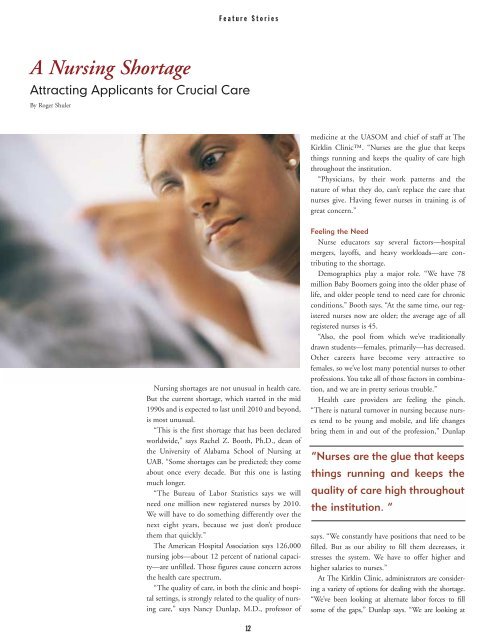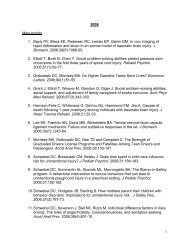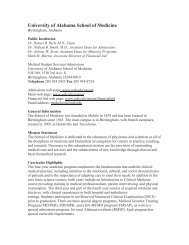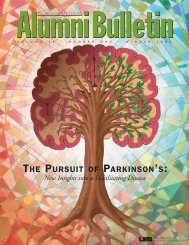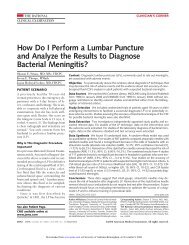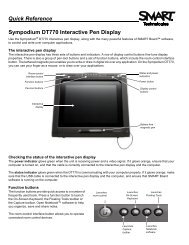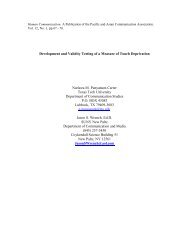AlumniBulletin - University of Alabama at Birmingham
AlumniBulletin - University of Alabama at Birmingham
AlumniBulletin - University of Alabama at Birmingham
You also want an ePaper? Increase the reach of your titles
YUMPU automatically turns print PDFs into web optimized ePapers that Google loves.
Fe<strong>at</strong>ure Stories<br />
A Nursing Shortage<br />
Attracting Applicants for Crucial Care<br />
By Roger Shuler<br />
medicine <strong>at</strong> the UASOM and chief <strong>of</strong> staff <strong>at</strong> The<br />
Kirklin Clinic. “Nurses are the glue th<strong>at</strong> keeps<br />
things running and keeps the quality <strong>of</strong> care high<br />
throughout the institution.<br />
“Physicians, by their work p<strong>at</strong>terns and the<br />
n<strong>at</strong>ure <strong>of</strong> wh<strong>at</strong> they do, can’t replace the care th<strong>at</strong><br />
nurses give. Having fewer nurses in training is <strong>of</strong><br />
gre<strong>at</strong> concern.”<br />
Nursing shortages are not unusual in health care.<br />
But the current shortage, which started in the mid<br />
1990s and is expected to last until 2010 and beyond,<br />
is most unusual.<br />
“This is the first shortage th<strong>at</strong> has been declared<br />
worldwide,” says Rachel Z. Booth, Ph.D., dean <strong>of</strong><br />
the <strong>University</strong> <strong>of</strong> <strong>Alabama</strong> School <strong>of</strong> Nursing <strong>at</strong><br />
UAB. “Some shortages can be predicted; they come<br />
about once every decade. But this one is lasting<br />
much longer.<br />
“The Bureau <strong>of</strong> Labor St<strong>at</strong>istics says we will<br />
need one million new registered nurses by 2010.<br />
We will have to do something differently over the<br />
next eight years, because we just don’t produce<br />
them th<strong>at</strong> quickly.”<br />
The American Hospital Associ<strong>at</strong>ion says 126,000<br />
nursing jobs—about 12 percent <strong>of</strong> n<strong>at</strong>ional capacity—are<br />
unfilled. Those figures cause concern across<br />
the health care spectrum.<br />
“The quality <strong>of</strong> care, in both the clinic and hospital<br />
settings, is strongly rel<strong>at</strong>ed to the quality <strong>of</strong> nursing<br />
care,” says Nancy Dunlap, M.D., pr<strong>of</strong>essor <strong>of</strong><br />
Feeling the Need<br />
Nurse educ<strong>at</strong>ors say several factors—hospital<br />
mergers, lay<strong>of</strong>fs, and heavy workloads—are contributing<br />
to the shortage.<br />
Demographics play a major role. “We have 78<br />
million Baby Boomers going into the older phase <strong>of</strong><br />
life, and older people tend to need care for chronic<br />
conditions,” Booth says. “At the same time, our registered<br />
nurses now are older; the average age <strong>of</strong> all<br />
registered nurses is 45.<br />
“Also, the pool from which we’ve traditionally<br />
drawn students—females, primarily—has decreased.<br />
Other careers have become very <strong>at</strong>tractive to<br />
females, so we’ve lost many potential nurses to other<br />
pr<strong>of</strong>essions. You take all <strong>of</strong> those factors in combin<strong>at</strong>ion,<br />
and we are in pretty serious trouble.”<br />
Health care providers are feeling the pinch.<br />
“There is n<strong>at</strong>ural turnover in nursing because nurses<br />
tend to be young and mobile, and life changes<br />
bring them in and out <strong>of</strong> the pr<strong>of</strong>ession,” Dunlap<br />
“Nurses are the glue th<strong>at</strong> keeps<br />
things running and keeps the<br />
quality <strong>of</strong> care high throughout<br />
the institution. “<br />
says. “We constantly have positions th<strong>at</strong> need to be<br />
filled. But as our ability to fill them decreases, it<br />
stresses the system. We have to <strong>of</strong>fer higher and<br />
higher salaries to nurses.”<br />
At The Kirklin Clinic, administr<strong>at</strong>ors are considering<br />
a variety <strong>of</strong> options for dealing with the shortage.<br />
“We’ve been looking <strong>at</strong> altern<strong>at</strong>e labor forces to fill<br />
some <strong>of</strong> the gaps,” Dunlap says. “We are looking <strong>at</strong><br />
12


